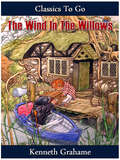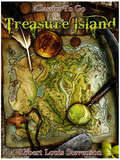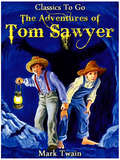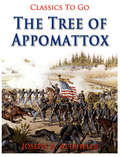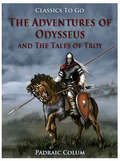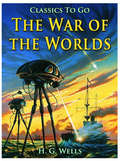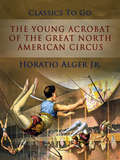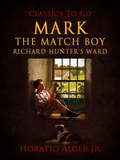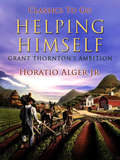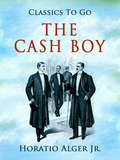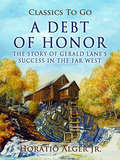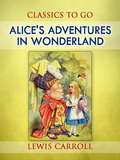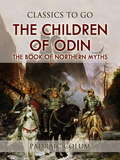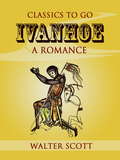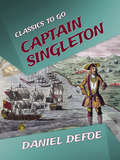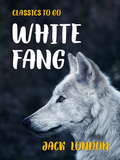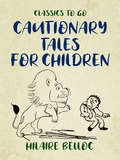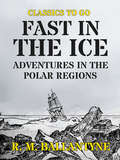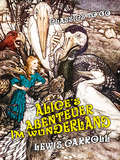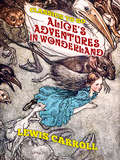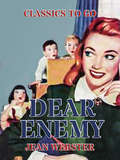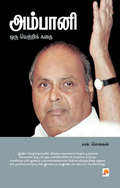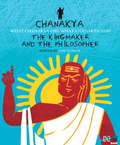- Table View
- List View
The Wind in the Willows: Revised Edition Of Original Version (Classics To Go)
by Kenneth GrahameAt the start of the book, it is spring time: the weather is fine, and good-natured Mole loses patience with spring cleaning. He flees his underground home, heading up to take in the air. He ends up at the river, which he has never seen before. Here he meets Ratty (a water rat), who at this time of year spends all his days in, on and close by the river. Rat takes Mole for a ride in his rowing boat. They get along well and spend many more days boating, with Rat teaching Mole the ways of the river. One summer day shortly thereafter, Rat and Mole find themselves near the grand Toad Hall and pay a visit to Toad. Toad is rich (having inherited wealth from his father): jovial, friendly and kind-hearted but aimless and conceited, he regularly becomes obsessed with current fads, only to abandon them as quickly as he took them up. Having only recently given up boating, Toad's current craze is his horse-drawn caravan. In fact, he is about to go on a trip, and persuades the reluctant Rat and willing Mole to join him. The following day (after Toad has already tired of the realities of camp life and sleeps-in to avoid chores), a passing motorcar scares the horse, causing the caravan to overturn into a ditch. Rat does a war dance and threatens to have the law on the motorcar drivers while Mole calms the horse, but this marks the immediate end of Toad's craze for caravan travel, to be replaced with an obsession for motorcars. When the three animals get to the nearest town, they have Toad go to the police station to make a complaint against the vandals and their motorcar and thence to a blacksmith to retrieve and mend the caravan. Toad - in thrall to the experience of his encounter - refuses. Rat and Mole find an inn from where Mr. Toad's horse is taken care of and they organise the necessary steps and, exhausted, return home by train. Meanwhile, Toad makes no effort to help, instead deciding to order himself a motorcar. (Excerpt from Wikipedia)
Treasure Island: Prince Otto (Classics To Go)
by Robert StevensonThe narrator, James "Jim" Hawkins, is the young son of the owners of the Admiral Benbow Inn. An old drunken seaman named Billy Bones becomes a long-term lodger at the inn, only paying for about the first week of his stay. Jim quickly realizes that Bones is in hiding, and that he particularly dreads meeting an unidentified seafaring man with one leg. Some months later, Bones is visited by a mysterious sailor named Black Dog. Their meeting turns violent, Black Dog flees and Bones suffers a stroke. While Jim cares for him, Bones confesses that he was once the mate of a notorious late pirate, Captain Flint, and that his old crew-mates want Bones' sea chest. Some time later, another of Bones' crew mates, a blind man named Pew, appears at the inn and forces Jim to lead him to Bones. Pew gives Bones a paper. After Pew leaves, Bones opens the paper to discover it is marked with the Black Spot, a pirate summons, with the warning that he has until ten o'clock to meet their demands. Bones drops dead of apoplexy (in this context, a stroke) on the spot. Jim and his mother open Bones' sea chest to collect the amount due to them for Bones' room and board, but before they can count out the money that they are owed, they hear pirates approaching the inn and are forced to flee and hide, Jim taking with him a mysterious oilskin packet from the chest. The pirates, led by Pew, find the sea chest and the money, but are frustrated that there is no sign of "Flint's fist". Customs men approach and the pirates escape to their vessel, all except for Pew, who is accidentally run down and killed by the agents' horses.... (Excerpt from Wikipedia)
The Adventures of Tom Sawyer: Revised Edition Of Original Version (Classics To Go #305)
by Mark TwainTom Sawyer lived with his Aunt Polly and his half-brother, Sid. Tom dirties his clothes in a fight and is made to whitewash the fence the next day, as punishment. He cleverly persuades his friends to trade him small treasures for the privilege of doing his work. In Sunday school, Tom does not manage to get a Bible because Mr. Walters knew he was trading tickets. Tom falls in love with Becky Thatcher, a new girl in town, and persuades her to get "engaged" by kissing him. But their romance collapses when she learns Tom has been "engaged" previously, to a girl named Amy Lawrence. Shortly after being shunned by Becky, Tom accompanies Huckleberry Finn to the graveyard at night, where they witnessed the murder of Dr. Robinson. Tom, Huck, and Joe Harper run away to an island. While enjoying their newfound freedom, the boys become aware that the community is sounding the river for their bodies. Tom sneaks back home one night to observe the commotion. After a brief moment of remorse at his loved ones' suffering, Tom is struck by the idea of appearing at his funeral. Back in school, Tom gets himself back in Becky's favour after he nobly accepts the blame for a book she has ripped. Soon, Muff Potter's trial begins, in which Tom testifies against 'Injun Joe'. Potter is acquitted, but 'Injun Joe' flees the courtroom through a window. Tom then begins to fear for his life as 'Injun Joe' is at large and can easily find him. Summer arrives, and Tom and Huck go hunting for buried treasure in a haunted house. After venturing upstairs they hear a noise below. Peering through holes in the floor, they see 'Injun Joe' disguised as a deaf-mute Spaniard; 'Injun Joe' and his companion plan to bury some stolen treasure of their own. From their hiding spot, Tom and Huck wriggle with delight at the prospect of digging it up. Huck begins to shadow 'Injun Joe' nightly, watching for an opportunity to nab the gold. Meanwhile, Tom goes on a picnic to McDougal's Cave with Becky and their classmates. That same night, Huck sees 'Injun Joe' and his partner making off with a box. He follows and overhears their plans to attack the Widow Douglas. By running to fetch help, Huck stops the violence and becomes an anonymous hero. A week later, Tom takes Huck to the cave and they find the box of gold, the proceeds of which are invested for them. The Widow Douglas adopts Huck, and, when Huck attempts to escape civilised life, Tom tricks him into thinking if Huck returns to the widow, he can join Tom's robber band. Reluctantly, Huck agrees and goes back to the Widow Douglas.
The Tree of Appomattox: A Story Of The Civil War's Close (Classics To Go #Vol. 8)
by Joseph AltshelerJoseph Alexander Altsheler (April 29, 1862 – June 5, 1919) was an American newspaper reporter, editor and author of popular juvenile historical fiction. His seven series comprise a total of thirty-two novels, each containing an independent story. The entire French and Indian War Series is very well written and accurate in its details. The characters were well developed and it is an excellent series combining historical fact and adventure with good fiction as are all of Altsheler's War Series.
The Adventures of Odysseus and The Tales of Troy: Revised Edition Of Original Version (Classics To Go)
by Padraic ColumAlso known as “The Children’s Homer,” this is Irish writer Padraic Colum’s retelling of the events of Homer’s Iliad and Odyssey for young people. Colum’s rich, evocative prose narrates the travails of Odysseus, King of Ithaca: his experiences fighting the Trojan War, and his ten years’ journey home to his faithful wife Penelope and his son Telemachus. (Summary by Elizabeth Klett )
The War of the Worlds: Revised Edition Of Original Version (Classics To Go #4)
by H. G. WellsThe War of the Worlds is a science fiction novel by eng author H. G. Wells. It is the first-person narrative of the adventures of an unnamed protagonist and his brother in Surrey and London as Earth is invaded by Martians. Written between 1895 and 1897, it is one of the earliest stories that detail a conflict between mankind and an extraterrestrial race. The novel is one of the most commented-on works in the science fiction canon. (Excerpt from Wikipedia)
The Young Acrobat of The Great North American Circus (Classics To Go)
by Jr. AlgerKit, a young teen boy, is an orphan. He is cheated of his inheritance by his guardian. His guardian sends him off to work with a brutal, stupid blacksmith. The boy runs away. He joins the circus. He is followed by the blacksmith. The boy stays away from him. He becomes a big star in the circus. Later, he is restored to his rightful place with the help of a man who was his father's friend.(Excerpt from Wikipedia)
Mark the Match Boy (Classics To Go)
by Jr. AlgerThe book takes the reader through the Children's Lodging House, the Bowery Theatre, and the Fulton ferry, besides giving one a description of the life of bootblacks, match boys, apple girls, Bowery B'hoys and other assorted street creatures living in New York.
Helping Himself: Grant Thornton's Ambition (Classics To Go)
by Jr. AlgerIn Alger's books real boys are seen doing honest things and being successful. Helping Himself begins with Deacon Gridley who was a farmer. Gridley had managed to save a little money. His thriftiness meant that he had also hoarded all of the interest. Here our young hero enters the tale.
The Cash Boy: Inspirational Story About A Poor Boy Ascending To Great Wealth And Fame (Classics To Go)
by Jr. AlgerFrank Fowler leaves his small town home shortly after the death of the only mother he has ever known to make his fortune in New York. These small town adventures are fully loaded with stock Alger characters…
Young Captain Jack / The Son of a Soldier: The Son Of A Soldier (The World At War)
by Edward StratemeyerHoratio Alger, Jr.; January 13, 1832 – July 18, 1899) was a prolific 19th-century American author, best known for his many juvenile novels about impoverished boys and their rise from humble backgrounds to lives of middle-class security and comfort through hard work, determination, courage, and honesty. His writings were characterised by the "rags-to-riches" narrative, which had a formative effect on America during the Gilded Age. His popularity—and income—dwindled in the 1890s. In 1896, he had (what he called) a "nervous breakdown"; he relocated permanently to his sister's home in South Natick, Massachusetts. Before his death, Alger asked Edward Stratemeyer to complete his unfinished works.[56] In 1901, “Young Captain Jack” was completed by Stratemeyer and promoted as Alger's last work. Alger once estimated that he earned only $100,000 between 1866 and 1896; at his death he had little money, leaving only small sums to family and friends. His literary work was bequeathed to his niece, to two boys he had casually adopted, and to his sister Olive Augusta, who destroyed his manuscripts and his letters at his wish. (Excerpt from Wikipedia)
A Debt of Honor: The Story Of Gerald Lane's Success In The Far West (Classics To Go)
by Jr. AlgerGerald Lane heads west to seek his fortune and claim the money owed his father by an unscrupulous former business partner.
Alice's Adventures in Wonderland: Webster's Italian Thesaurus Edition (Classics To Go)
by Lewis CarrollAlice's Adventures in Wonderland (commonly shortened to Alice in Wonderland) is an 1865 novel written by English author Charles Lutwidge Dodgson under the pseudonym Lewis Carroll. It tells of a young girl named Alice falling through a rabbit hole into a fantasy world populated by peculiar, anthropomorphic creatures. The tale plays with logic, giving the story lasting popularity with adults as well as with children. It is considered to be one of the best examples of the literary nonsense genre. Its narrative course, structure, characters, and imagery have been enormously influential in both popular culture and literature, especially in the fantasy genre. (Wikipedia)
The Children of Odin The Book of Northern Myths: The Book Of Northern Myths (Classics To Go)
by Padraic ColumFrom master storyteller Padriac Colum, winner of a Newbery Honor for The Golden Fleece, comes a collection of fifteen timeless tales inspired by Norse mythology. (Amazon)
Ivanhoe: The Works Of Sir Walter Scott (Classics To Go)
by Walter ScottIvanhoe is set in 12th-century England, with colourful descriptions of a tournament, outlaws, a witch trial and divisions between Jews and Christians. It has been credited for increasing interest in romance and medievalism; John Henry Newman claimed Scott "had first turned men's minds in the direction of the Middle Ages". (Excerpt from Wikipedia)
Captain Singleton: The Life, Adventures, And Piracies Of Captain Singleton (Classics To Go)
by Daniel DefoeThe book tells the story of Bob Singleton, who had been kidnapped as a boy from a good home and grew up with no real home. He came aboard a ship and eventually ended up being cast on an island with other crewmen. They managed to get to Africa and about the first half of the novel deals with the company's travel through Africa until they found a port from which they could get back to Europe. After their return there Singleton became member of another ships' crew and after a mutiny they led the lives of pirates with Singleton as their captain, which mostly covers the last half of the book, finishing in Singleton and a friend being repentant, leaving of their (successful) lives as pirates and returning home in disguise to find a peaceful life. (Excerpt from Goodreads)
White Fang: Literary Touchstone Classic (Classics To Go)
by Jack LondonThe story of a wolf-dog who endures great cruelty before he comes to know human kindness.
Cautionary Tales for Children: Designed For The Admonition Of Children Between The Ages Of Eight And Fourteen Years (classic Reprint) (Classics To Go)
by Hilaire BellocFor readers of any age, a witty and strikingly irreverent collection of moral guidance Most notable among prolific English satirist Hilaire Belloc's writings are the sharp and clever admonishments he composed for children. Collected here and illustrated to wonderful haunting effect by Edward Gorey, these short, funny pieces offer moral instruction for all types of mischief makers—from a certain young Jim, "who ran away from his nurse and was eaten by a lion," to the tale of Matilda, "who told lies and was burned to death”—and add up to a delightful read for any fan of Roald Dahl or Shel Silverstein. (Goodreads)
Fast in the Ice Adventures in the Polar Regions: Or Adventures In The Polar Regions (1870) (Classics To Go)
by R. M. BallantyneOne day, many years ago, a brig cast off from her moorings, and sailed from a British port for the Polar Seas. That brig never came back. Many a hearty cheer was given, many a kind wish was uttered, many a handkerchief was waved, and many a tearful eye gazed that day as the vessel left Old England, and steered her course into the unknown regions of the far north. (Goodreads)
Alice's Abenteuer im Wunderland: Large Print (Classics To Go)
by Lewis CarrollAlice im Wunderland gilt als eines der hervorragenden Werke aus dem Genre des literarischen Nonsens. Gemeinsam mit der 1871 erschienenen Fortsetzung Alice hinter den Spiegeln wird dieses Kinderbuch zu den Klassikern der Weltliteratur gezählt. So ist die Erzählung heute beispielsweise Bestandteil der ZEIT-Bibliothek der 100 Bücher. Die britische Zeitung The Guardian nahm 2009 sowohl Alice im Wunderland als auch Alice hinter den Spiegeln in die Liste der 1000 Romane auf, die jeder gelesen haben muss. Die Erzählweise und -struktur, die Figuren und die Metaphorik haben unverändert großen kulturellen Einfluss. Alice im Wunderland erfuhr Adaptionen für die Bühne und im Film. Figuren der Erzählung, wie zum Beispiel die Grinsekatze, der Jabberwocky, der Märzhase und der verrückte Hutmacher, oder einzelne Episoden, wie beispielsweise die der Teegesellschaft, in die Alice hineingerät, wurden in der Popkultur immer wieder aufgegriffen und zitiert. (Wikipedia)
Alice's Adventures in Wonderland: Webster's Italian Thesaurus Edition (Classics To Go)
by Lewis CarrollAlice's Adventures in Wonderland (commonly shortened to Alice in Wonderland) is an 1865 novel written by English author Charles Lutwidge Dodgson under the pseudonym Lewis Carroll. It tells of a young girl named Alice falling through a rabbit hole into a fantasy world populated by peculiar, anthropomorphic creatures. The tale plays with logic, giving the story lasting popularity with adults as well as with children. It is considered to be one of the best examples of the literary nonsense genre. Its narrative course, structure, characters, and imagery have been enormously influential in both popular culture and literature, especially in the fantasy genre. (Wikipedia)
Dear Enemy: Large Print (Classics To Go)
by Jean WebsterDear Enemy is the sequel to Jean Webster's novel Daddy-Long-Legs. First published in 1915, it was among the top ten best sellers in the US in 1916. The story is presented in a series of letters written by Sallie McBride, Judy Abbott's classmate and best friend in Daddy-Long-Legs. Among the recipients of the letters are Judy; Jervis Pendleton, Judy's husband and the president of the orphanage where Sallie is filling in until a new superintendent can be installed; Gordon Hallock, a wealthy Congressman and Sallie's later fiancé; and the orphanage's doctor, embittered Scotsman Robin 'Sandy' MacRae (to whom Sallie addresses her letters: "Dear Enemy"). Webster employs the epistolary structure to good effect; Sallie's choices of what to recount to each of her correspondents reveal a lot about her relationships with them. (Wikipedia)
Ambani: அம்பானி
by என். சொக்கன்"இந்தியாவில் தொழில்முனைவோராக விரும்புபவர்களுக்கெல்லாம் முக்கிய ஆதர்சமாகத் திகழ்பவர் திருபாய் அம்பானி. மிகச் சாதாரணப் பின்னணியிலிருந்து தொடங்கி படிப்படியாக முன்னேறி ரிலையன்ஸ் எனும் மாபெரும் சாம்ராஜ்ஜியத்தை உருவாக்கியவர் திருபாய் அம்பானி. துணிமணி வியாபாரத்திலிருந்து ஆரம்பித்து, அதன்பின் துணிகளைத் தயாரித்து, பின் பாலியெஸ்டர் வியாபாரம், பாலியெஸ்டர் உற்பத்தி, அதன்பின் பாலியெஸ்டர் உற்பத்திக்கான மூலப்பொருள்களை உருவாக்குவது, அந்த மூலப்பொருள்களின் ஆதாரமான பெட்ரோலிய சுத்திகரிப்பு, அங்கிருந்து பெட்ரோலையே தரையிலிருந்தும், கடலுக்கு அடியிலும் தோண்டுவது என்று படிப்படியாக, பார்த்துப் பார்த்து தன் தொழிற்சாலைகளைக் கட்டியவர். அம்பானி 70 mm அளவுக்கு விரிந்த திரையில் கனவு கண்டார். பிரம்மாண்டமாக மட்டுமே யோசித்தார். அதன் விளைவுதான் இன்று ரிலையன்ஸ் இந்தியாவிலேயே மிகப்பெரிய தனியார் நிறுவனமாக உள்ளது. ஆனால் இத்தனையும் அதிர்ஷ்டத்தால் வந்ததல்ல. உழைப்பால், தைரியத்தால், முயற்சியால் வந்தது. அதே சமயம் காலத்துக்குத் தகுந்தாற்போல அரசுகளையும் அதிகாரிகளையும் தனக்குச் சாதகமாக வளைத்துக் கொள்வதன் மூலமும் அரசு உத்தரவுகளை தன் வசதிக்கேற்றவாறு புரிந்துகொள்வதன் மூலமும் அம்பானி தன் நிறுவனத்தை வளர்த்தார். அம்பானி, தன்னை எதிர்ப்பவர்களை அவர்களது ஆயுதங்களைக் கொண்டே மழுங்கடித்தார். இன்றைய காலகட்டத்தில் திருபாய் அம்பானியின் சில செயல்கள் நமக்கு ஏற்புடையதாக இருக்காது. ஆனால் அவரது விடாமுயற்சி, தன்னம்பிக்கை, இந்தியா மீதான பற்று, சக ஊழியர்கள் மீதான மரியாதை, தொழில் மீதான ஆழ்ந்த பக்தி ஆகியவை இன்றைக்கும் நம் அனைவருக்கும் வழிகாட்டக் கூடியவை. இந்தப் புத்தகம் அம்பானியின் வாழ்க்கை வரலாறு மட்டுமல்ல, கடந்த நாற்பதாண்டுகளில் இந்தியாவின் தொழில்துறையின் வரலாறும் இதில் அடங்கியிருக்கிறது. எந்தவொரு சுய முன்னேற்ற நூலைக் காட்டிலும் பன்மடங்கு அதிகமான பலனை இந்தப் புத்தகத்தினைப் படிப்பதன் மூலம் ஒருவர் அடைய முடியும். இது நிஜமான வாழ்க்கை, வெறும் ஏட்டுச் சுரைக்காய் அல்ல." கிழக்கு பதிப்பகம் | Kizhakku pathippagam
Chanakya: The Kingmaker And The Philosopher
by Anu Kumar“A learned man and a king are not equal, as the former is respected everywhere, but the latter only in his own dominions.” Canny, contemplative and courageous, Chanakya is known as one of India’s most multifaceted and enduring gurus. His smart, sage advice, captured forever in the twin classic treatises – the Arthashastra and the Nitishastra – has both the detailing of a draughtsman and the wide-ranging wisdom of a genius. Scholar, teacher, visionary, political strategist, economic philosopher and royal adviser, Chanakya put forth invaluable lessons that changed the course of history. Humiliated by Dhana Nanda, the ruler of Magadha, Chanakya turned adversity into strength and challenge into opportunity. Through clever diplomatic manoeuvres and wise confrontations, he choreographed young Chandragupta’s rise as the founder of the Mauryan empire, the first of its kind in power and territorial extent. Melding his knowledge with a shrewd observance of life, Chanakya outlined political and economic philosophies in a long-lasting body of pithy truths. And that is why, centuries later, his work and his words matter in today’s world. This book brings together the transformative incidents that shaped Chanakya’s life, and his most important sayings. From his understanding of the ideal way of life, you too can learn to be a little bit like Chanakya. PLUS * Flipbook action page corner for a touch of fun * Timeline: A chronology of Chanakya’s life * Bonus Teachings!: A hundred tactical tips from Chanakya’s treasury of wisdom
Meri Bindi (My Bindi)
by Anu AnandBindis can be big and small, red and blue, long and sparkly! Join Noor and Neel as their tiger friend Moochhar Singh leads them to a land filled with colourful characters, all of them wearing their favourite bindis! The first of the Meri Duniya (My World) series of bilingual Hindi–English books, Meri Bindi (My Bindi) is filled with imaginative handmade illustrations explained with three lines of text – in Hindi, how to say it, and the English translation.
